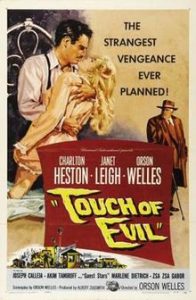La pregunta por la identidad ha estado presente desde el principio de nuestro curso ¿Quién lleva la máscara? ¿Quién está fingiendo: Diego Vega, Zorro, Francois Merlin, Bob Sinclar? En el caso del Zorro, hablábamos de 3 identidades insertas en una misma persona: Zorro, el de capa y antifaz; Diego Vega: ese hombre lacónico y adinerado, con propensión a la pereza; y Douglas Fairbanks: el actor que los encarnó a ambos, y que fue una de las primeras estrellas de cine de Hollywood. Multiplicidades narrativas que tergiversan los límites entre lo real y lo fantástico, y que enriquecen en gran medida el análisis de estos productos culturales.
“Touch of evil”, claro, no escapa a la pregunta por la identidad. Estamos en una zona de frontera, en donde los flujos son constantes e intercambiables, y las definiciones estáticas o anquilosadas parecen no compatibles con el dinamismo mismo que la película ofrece. El objetivo final del filme, podríamos decir, es el de desenmascarar; revelar la verdadera identidad de Hank Quinlan, descubriéndolo como un policía corrupto que implicaba falsamente a los presuntos responsables de crímenes. Y detrás de esta trama se descubren también sus miserias personales, con una alcoholemia latente que aflora nuevamente con las sindicaciones de Vargas, y la tristeza cotidiana en el recuerdo de su esposa asesinada. Un nuevo rostro que se suma al que en principio nos fue ofrecido: el de un policía honesto al que las intuiciones de su pierna nunca le fallaban.
Pero la película no se agota, ni mucho menos, en las múltiples identidades de Quinlan, quien además es Orson Welles, director y guinista del filme. Las multiplicidades se presentan constantemente, intersectándose y descomponiéndose: el matrimonio entre un mexicano y una americana, y sus tránsitos de México a los Estados Unidos y luego de vuelta a México; los avatares de la familia Grandi, que aparentan ser simples comerciantes pero que en realidad manejan negocios turbios, y asentados en México tienen moteles en los Estados Unidos (incluso uno de los sobrinos del Tío Joe, quien en principio aparenta no saber inglés, luego lo habla fluidamente cuando asume el papel de encargado del Motel); o la imagen misma del primer encargado nocturno del Motel (Dennis Weaver), que se abre como una incógnita durante toda la película: una figura enigmática, oscura, inclasificable, a quien no logramos ver nítidamente más allá de sus evidentes discapacidades.
Quizás, quien mejor representa este papel de la apariencia en la película, es el detective Miguel Vargas. En él confluyen múltiples narrativas del film: es Miguel, pero también es hasta cierto punto Mike; es blanco, pues detrás está Charlton Heston, pero también es moreno, pues ha sido pintado para interpretar el rol; es mexicano, de forma evidente, pero no podemos negar que en otro nivel también es americano; alega también que Hank Quinlan ha recurrido a pruebas falsas para sindicar a presuntos culpables de delitos, pero él también utiliza artimañas a la hora de “desenmascarar” a Quinlan, grabando su voz en secreto mientras lo persigue por el campo petrolero; es esposo huído en su luna de miel para poder ser detective, y jugar así con los dos rostros que le permitan comprobar que es un buen mexicano: “Vargas speaks”, dice Pease, “as a representative of the Mexican state eager to divert international attention away from evidence of its inability to regulate its borders. But he also acts as a husband intent on disproving his wife’s belief that Mexico is unable to protect its citizenry”.
Como Zorro, Diego Vega y Douglas Fairbanks, Miguel Vargas (Mike) también es muchos. Es esposo (mal esposo quizás), detective, abogado, representante del estado mexicano, investigador, mexicano americanizado en el nivel de la ficción: Vargas, americano mexicanizado en el nivel de la realidad: Heston. Racial y socialmente es un héroe para algunos, pero sin lugar a dudas es también un antihéroe para otros…
Las preguntas nuevamente asoman: ¿quién está fingiendo?, ¿quién es el verdadero?


